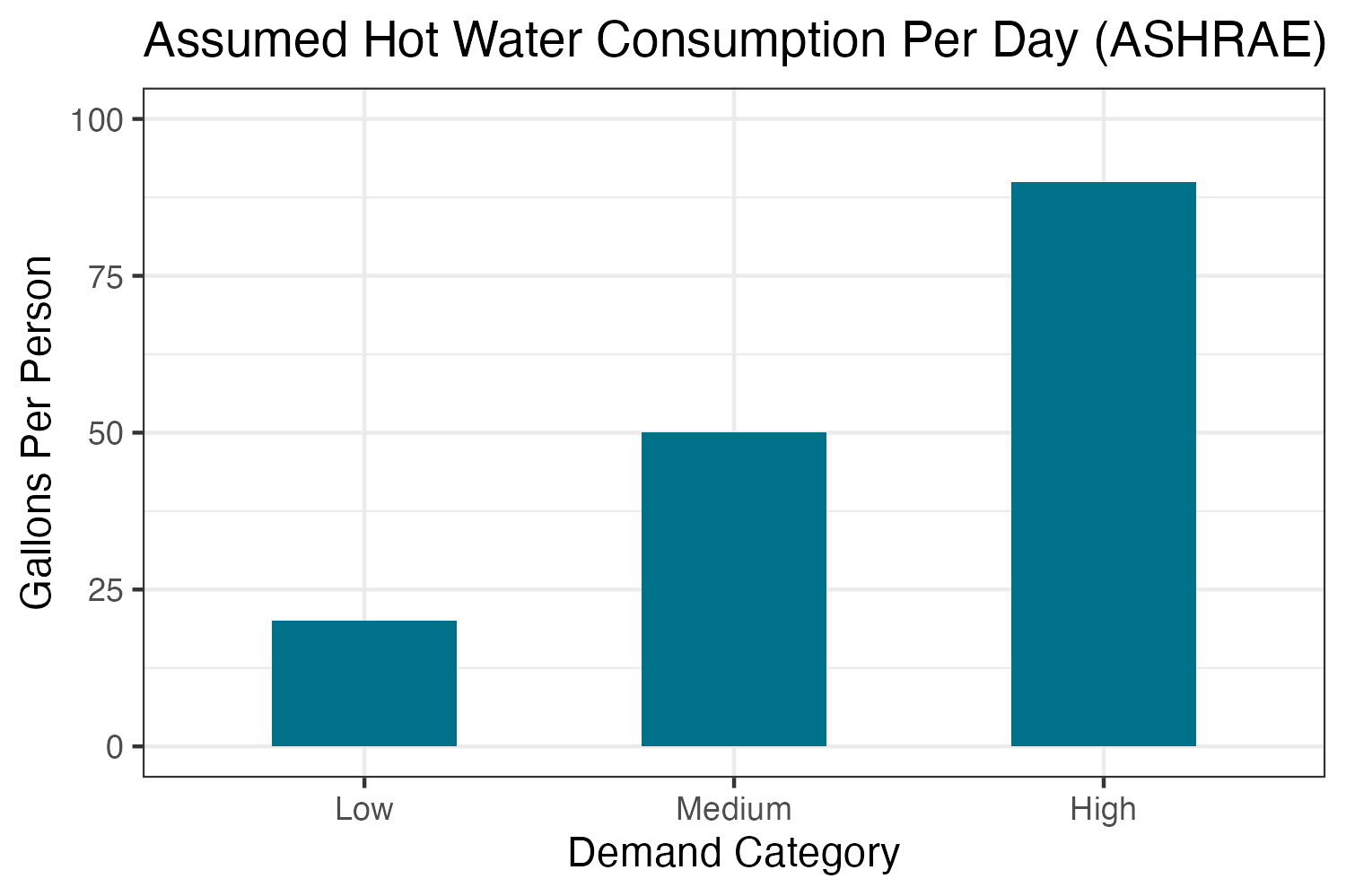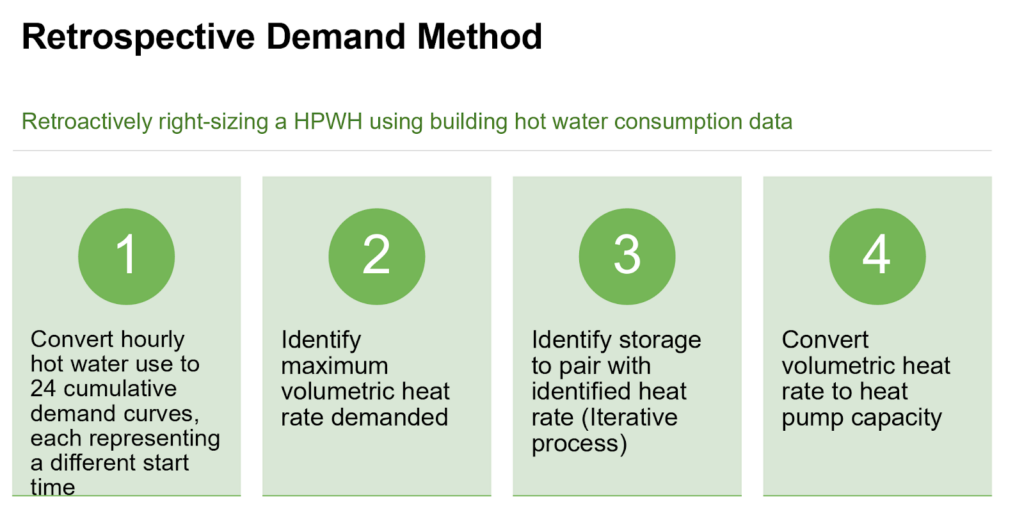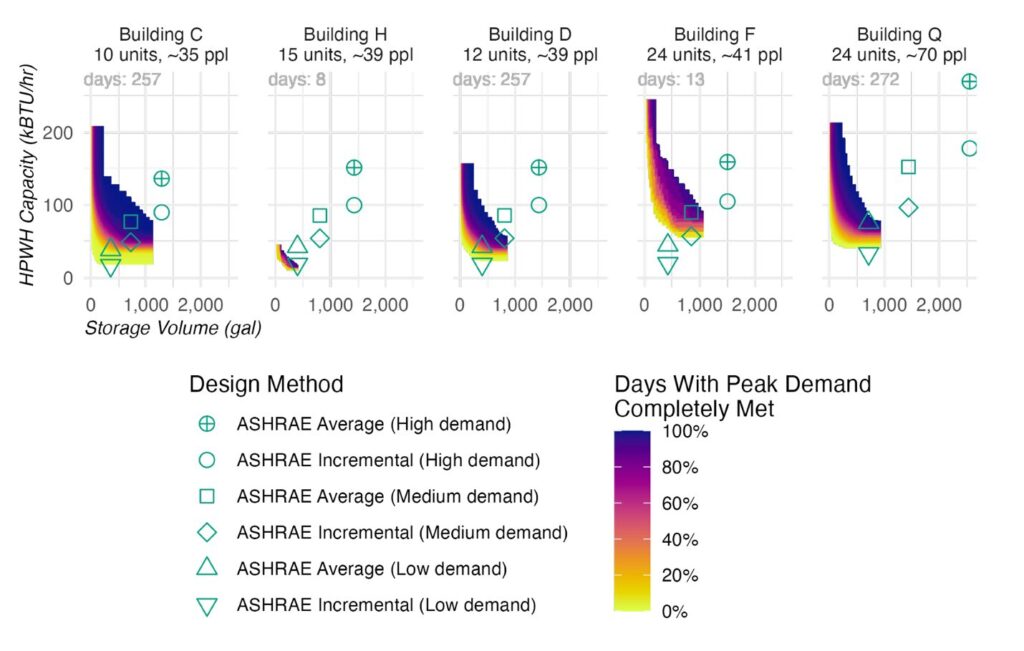
Right-Sizing Central Heat Pump Water Heaters: A Data-Driven Path to Better Design Guidelines and Plumbing Codes
In the pursuit of equitable and cost-effective building decarbonization, stakeholders involved in energy policy and building performance play a critical role in shaping codes and standards that reflect today’s technologies and tomorrow’s climate goals. One area of increasing attention is water heating—specifically, the promotion and sizing of heat pump water heaters (HPWHs) in multifamily buildings.
Traditionally, hot water system sizing has relied heavily on predictive methods outlined in the ASHRAE Handbook, with assumptions based on data that is decades old. These outdated methods often lead to oversized systems that inflate upfront costs and energy consumption, or undersized systems that can’t reliably meet tenant needs. Both outcomes are barriers to electrification and adoption of HPWHs.
To address this issue, 2050 Partners conducted a detailed analysis of real-world hot water use data that retrospectively selected perfectly sized HPWH for multifamily buildings. The findings—presented at the 2025 ACEEE Hot Water and Hot Air Forums—offer actionable insights for those seeking to advance energy efficiency standards and accelerate market transformation through better-informed codes. This work was supported by California’s Statewide Utility Codes and Standards Program, with contributions from Gary Klein and Associates.
The Problem: Outdated Sizing Assumptions Are Holding Us Back
HPWHs offer a highly efficient, all-electric alternative to gas water heating systems, but they must be sized using different methods. Unlike gas-fired water heaters, HPWHs heat water more slowly and can be significantly more expensive to install if the heat pump is oversized, creating roadblocks to building decarbonization efforts. Accurate heat pump and storage tank sizing is essential to manage installation costs and maintain system performance.
Yet, the ASHRAE Handbook’s hot water demand curves are based on data from 30 to 60 years ago, with demographic assumptions that are increasingly out of sync with real building usage. Current methods for estimating peak hot water demand classify buildings into “low,” “medium,” or “high” demand groups based on ambiguous demographic criteria and require selection of a difficult to understand “peak hour” parameter, leading to inconsistent system designs. These inconsistencies translate to missed energy and cost savings opportunities.
The graph below shows ASHRAE’s daily hot water use assumptions per person for each demand category. As you can see, demographic selection has a large impact on a household’s predicted hot water consumption.

A New Approach: Retrospective Demand-Based Sizing
To assess the accuracy of ASHRAE sizing methodology, 2050 Partners analyzed high-resolution hot water usage data from eight California multifamily buildings, representing a range of building types, occupancy patterns, and climate zones. This usage data was originally collected to support development of CPC Appendix M, and detailed building information can be found in this report: CPC Appendix M: Alternative Methodology for Calculating Peak Water Demand. The table below summarizes relevant characteristics for the eight buildings studied.
| Building | City | Monitored Apartments | Monitoring Period (day) | Logging Interval (sec) | Occupancy Type |
|---|---|---|---|---|---|
| B | Oakland, CA | 8 | 10 | 1 | Market Rate |
| C* | Atascadero, CA | 10 | 257 | 60 | Low Income |
| D* | Atascadero, CA | 12 | 257 | 60 | Low Income |
| F | Oakland, CA | 24 | 14 | 1 | Market Rate |
| H | San Francisco, CA | 15 | 9 | 1 | Low Income |
| M | San Francisco, CA | 120 | 12 | 1 | Low Income |
| N | San Francisco, CA | 134 | 12 | 1 | Low Income |
| Q | Sunnyvale, CA | 24 | 272 | 60 | Low Income |
| * Buildings C and D are similar; part of a larger complex. | |||||
The analysis used a method developed by Zhang et al. (2020) in an ACEEE 2020 Summer Study presentation titled “Balancing Heating Capacity and Storage Volume in Heat Pump Water Heater Systems.” The methodology was adapted to scale efficiently while evaluating large datasets of real-world demand profiles, and the adaptations were reviewed and approved by Zhang via video call. The set of effective sizing combinations (storage and capacity pairs that meet peak demand without oversizing) allows for operation times of between 8 and 22 hours per day and assumes that water is being heated by 90°F. A complete explanation of the demand-based sizing methodology is outside the scope of this article, but additional details can be found in slides 8 through 13 of the full presentation.

Key Findings: ASHRAE Methods Don’t Match Real Demand
ASHRAE’s predictive sizing methods were compared with the heat pump heating rate and storage volume pairs obtained from the demand-based sizing method. Across all eight buildings, ASHRAE’s two predictive methods produced widely varying results:
- High-demand assumptions tended to oversize HPWH systems, inflating cost and footprint.
- Low-demand assumptions consistently undersized systems, leading to potential hot water shortages.
- Medium-demand assumptions were inconsistent, performing well in some buildings and poorly in others.
In contrast, the demand-based sizing method provided a clear, building-specific range of heat pump and storage volume pairs that could reliably meet hot water needs while minimizing capital investment. In the chart below, you can see the variation in ASHRAE predicted hot water demand (teal markers) relative to actual hot water needs in each building. Some teal markers land in the orange or yellow bands, indicating that the design would meet demand on some, but not all, days.

As expected, the analysis demonstrated that heat pump capacity and storage volume are inversely correlated—meaning that a smaller heat pump can work effectively if it is paired with a larger storage tank. This insight opens the door to design flexibility and cost optimization, which is especially important in retrofit scenarios where space or equipment budgets may be constrained.
Pathways to Smarter Design Guidelines and Building Codes
This research highlights the importance of using real-world performance data to inform guidance and drive improvements to HPWH sizing recommendations in energy and building codes. Future opportunities include:
- Supporting the ASHRAE GPC-47 effort to develop updated HPWH sizing guidance.
- Leveraging existing hot water usage datasets to validate or enhance tools like EcoSizer, improving industry-wide sizing accuracy.
- Evaluating potential code change proposals in the California Plumbing Code, IAPMO’s Uniform Plumbing Code, and/or the California Energy Code to ensure they reflect modern heat pump performance characteristics.
- Modeling energy savings impacts using tools like CBECC or EnergyPlus to support effective policy and program design.
By investing in better central heat pump water heater sizing standards today, our industry can unlock the full potential of heat pump technologies and play a pivotal role in the transition to zero-carbon buildings.
We hope this overview has helped you increase your understanding of central HPWH sizing methods and potential improvements. If you are interested in learning more about building decarbonization or the work we do at 2050 Partners, we’d love to speak with you. Please contact us today!


